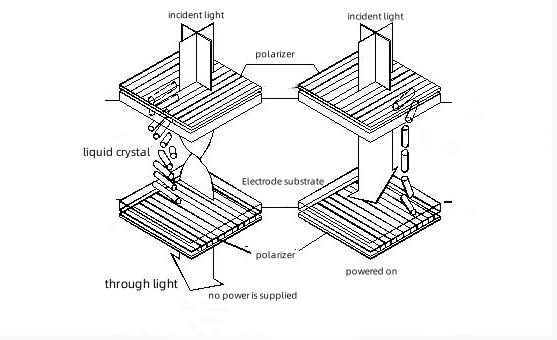The liquid crystal display devices used in common watches, digital meters, electronic clocks and most calculators are TN-type devices.
Generally speaking, as long as the liquid crystal displays used for pen-segment digital display are mostly TN-type devices.
1. Structural principles
The glass coated with the ITO transparent conductive layer is photoetched with a certain transparent electrode pattern, and the front and rear glass substrates with the transparent conductive electrode pattern are sandwiched with a layer of nematic liquid crystal with positive dielectric anisotropy. material, which is sealed on all sides to form a flat liquid crystal cell with a thickness of only a few microns. A layer of directional core film is coated on the inner surface of the glass and oriented, so that the liquid crystal molecules in the box are aligned parallel to the glass surface. The orientation treatment directions of the alignment layers on the inner surfaces of the two pieces of glass are perpendicular to each other, and the liquid crystal molecules are twisted at 90° between the two pieces of glass. This is the origin of the name of the twisted nematic liquid crystal display device.
2. Working principle
In TN-type liquid crystal display devices, the twisting helix of liquid crystal molecules in the box is much longer than the wavelength of visible light. Therefore, when linearly polarized light with the same or orthogonal arrangement of liquid crystal molecules along one side of the glass surface is incident, its polarization direction will change. After passing through the entire liquid crystal layer, it will be twisted 90° and emitted from the other side. Therefore, this liquid crystal cell has the function of blocking light between parallel polarizers and transmitting light between crossed polarizers.
If a voltage is applied to the liquid crystal cell at this time and reaches a certain value, the long axis of the liquid crystal molecules will begin to tilt along the direction of the electric field. When the voltage reaches about twice the threshold voltage, except for the liquid crystal molecules on the electrode surface, all the two liquid crystal molecules in the liquid crystal cell will The liquid crystal molecules between the electrodes become rearranged along the direction of the electric field. At this time, the 90° optical rotation function disappears, and the optical rotation function is lost between the crossed polarizers, making the device unable to transmit light. Due to the loss of optical rotation between parallel polarizers, the device can no longer block light, as shown in Figure .

Therefore, if the liquid crystal cell is placed between orthogonal or parallel polarizers, the light transmission and blocking state can be changed by energizing the liquid crystal cell, thereby achieving display. Usually when we see black characters appearing and disappearing in the LCD device, it is not that the liquid crystal is changing color, but that the LCD device allows light to pass through or be absorbed.
The operating threshold voltage U of the TN-type liquid crystal display device has nothing to do with the thickness of the liquid crystal cell; choosing a large dielectric constant and a small elastic constant can make the threshold voltage smaller. In actual use, the U of the TN-type liquid crystal cell is 2~3V, sometimes below 1V. .
3. Disadvantages
The main disadvantages of TN type liquid crystal display devices are as follows
(1) The electro-optical characteristics of TN-type liquid crystal are not steep, so the cross-effect is serious when working in dot matrix display mode. It is generally only suitable for static drive or dynamic drive segment display with less than four channels. At present, the best TN-type devices can only realize 8 to 16 channels of driving.
(2) The electro-optical response speed is slow. The response speed of TN-type LCD is about 100ms, so it is only suitable for displaying still or slow-changing images. Video display is beyond the capabilities of TN-type LCD.
(3) Neither light transmission nor closing is complete. It can only achieve the effect of black characters on gray paper, but cannot achieve the effect of black characters on a white background, so the contrast when displaying the picture is not ideal.
The above shortcomings determine that although TN-type liquid crystals are widely used, they are limited to low-end products in liquid crystals.







 Search
Search





